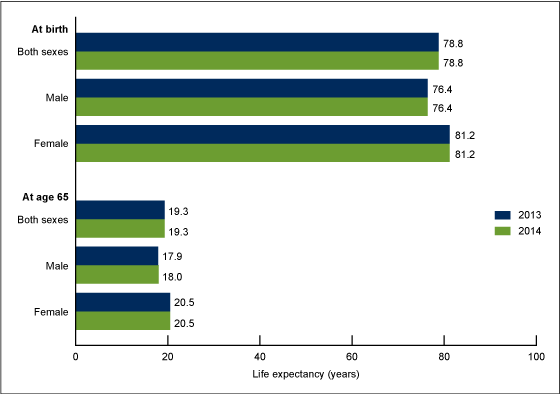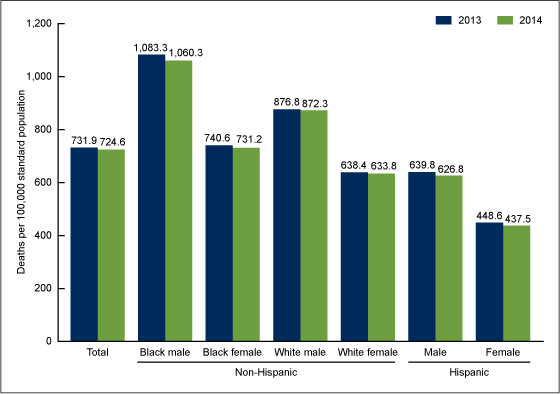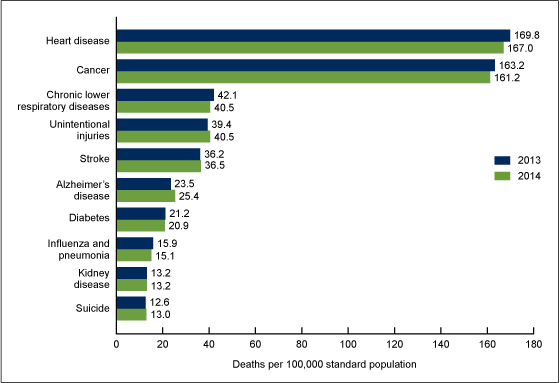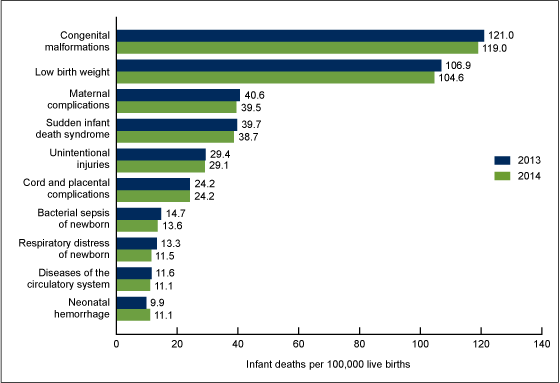Mortality in the United States, 2014
NCHS Data Brief No. 229, December 2015
PDF Version (711 KB)
Sherry L. Murphy, B.S.; Kenneth D. Kochanek, M.A.; Jiaquan Xu, M.D.; and Elizabeth Arias, Ph.D.
Key findings
Data from the National Vital Statistics System, Mortality
- Life expectancy for the U.S. population in 2014 was unchanged from 2013 at 78.8 years.
- The age-adjusted death rate decreased 1.0% to 724.6 deaths per 100,000 standard population in 2014 from 731.9 in 2013.
- The 10 leading causes of death in 2014 remained the same as in 2013. Age-adjusted death rates significantly decreased for 5 leading causes and significantly increased for 4 leading causes.
- The infant mortality rate decreased 2.3% to a historic low of 582.1 infant deaths per 100,000 live births. The 10 leading causes of infant death in 2014 remained the same as in 2013.
This report presents 2014 U.S. final mortality data on deaths and death rates by demographic and medical characteristics. These data provide information on mortality patterns among U.S. residents by such variables as sex, race and ethnicity, and cause of death. Information on mortality patterns is key to understanding changes in the health and well-being of the U.S. population. Life expectancy estimates, age-adjusted death rates by race and ethnicity and sex, the 10 leading causes of death, and the 10 leading causes of infant death were analyzed by comparing 2014 final data with 2013 final data (1).
Keywords: life expectancy, leading cause, death rates, National Vital Statistics System
How long can we expect to live?
Life expectancy at birth represents the average number of years that a group of infants would live if the group was to experience, throughout life, the age-specific death rates present in the year of birth. In 2014, life expectancy at birth was 78.8 years for the total U.S. population—81.2 years for females and 76.4 years for males (Figure 1), the same as in 2013. Life expectancy for females was consistently higher than life expectancy for males. In 2014, the difference in life expectancy between females and males was 4.8 years, the same as in 2013.
Figure 1. Life expectancy at selected ages, by sex: United States, 2013 and 2014
SOURCE: CDC/NCHS, National Vital Statistics System, Mortality.
Life expectancy at age 65 for the total population was 19.3 years, the same as in 2013. Life expectancy at age 65 was 20.5 years for females, unchanged from 2013, and 18.0 years for males, a 0.1-year increase from 2013. The difference in life expectancy at age 65 between females and males decreased 0.1 year, to 2.5 years in 2014 from 2.6 years in 2013.
Which population groups experienced reductions in mortality?
The age-adjusted death rate for the total population decreased 1.0% to a record low of 724.6 deaths per 100,000 standard population in 2014 from 731.9 in 2013. Age-adjusted death rates decreased significantly in 2014 from 2013 for non-Hispanic black males (2.1%), non-Hispanic black females (1.3%), non-Hispanic white males (0.5%), non-Hispanic white females (0.7%), Hispanic males (2.0%), and Hispanic females (2.5%) (Figure 2).
Figure 2. Age-adjusted death rates for selected populations: United States, 2013 and 2014
SOURCE: CDC/NCHS, National Vital Statistics System, Mortality.
What are the leading causes of death?
In 2014, the 10 leading causes of death—heart disease, cancer, chronic lower respiratory diseases, unintentional injuries, stroke, Alzheimer’s disease, diabetes, influenza and pneumonia, kidney disease, and suicide—remained the same as in 2013 (Figure 3). The 10 leading causes accounted for 73.8% of all deaths in the United States in 2014.
From 2013 to 2014, age-adjusted death rates significantly decreased for 5 of the 10 leading causes of death and significantly increased for 4 leading causes. The rate decreased by 1.6% for heart disease, 1.2% for cancer, 3.8% for chronic lower respiratory diseases, 1.4% for diabetes, and 5.0% for influenza and pneumonia. The rate increased by 2.8% for unintentional injuries, 0.8% for stroke, 8.1% for Alzheimer’s disease, and 3.2% for suicide. The rate for kidney disease in 2014 remained the same as in 2013.
Figure 3. Age-adjusted death rates for the 10 leading causes of death: United States, 2013 and 2014
NOTES: A total of 2,626,418 resident deaths were registered in the United States in 2014. The 10 leading causes accounted for 73.8% of all deaths in the United States in 2014. Access data table for Figure 3 [PDF – 514 KB]. Causes of death are ranked according to number of deaths.
SOURCE: CDC/NCHS, National Vital Statistics System, Mortality.
What are the leading causes of infant death?
The infant mortality rate (IMR)—the ratio of infant deaths to live births in a given year—is generally considered a good indicator of the overall health of a population. IMR declined 2.3% to a record low 582.1 infant deaths per 100,000 live births in 2014 from 596.1 in 2013.
The 10 leading causes of infant death in 2014 accounted for 69.1% of all infant deaths in the United States (Figure 4). The leading causes remained the same as in 2013. For Respiratory distress of newborn, IMR decreased 13.5% to 11.5 infant deaths per 100,000 live births in 2014 from 13.3 in 2013 (Figure 4). Mortality rates for other leading causes of infant death did not change significantly.
Figure 4. Infant mortality rates for the 10 leading causes of infant death: United States, 2013 and 2014
NOTES: A total of 23,215 deaths occurred in children under age 1 year in the United States in 2014, with an infant mortality rate of 582.1 infant deaths per 100,000 live births. The 10 leading causes of infant death in 2014 accounted for 69.1% of all infant deaths in the United States. Access data table for Figure 4 [PDF – 514 KB]. Causes of death are ranked according to number of deaths.
SOURCE: CDC/NCHS, National Vital Statistics System, Mortality.
Summary
From 2013 to 2014, the age-adjusted death rate for the total population declined 1.0%, and life expectancy at birth remained unchanged at 78.8 years. In 2014, a total of 2,626,418 resident deaths were registered in the United States. The age-adjusted death rate declined for each major race and ethnicity group by sex. Significant decreases in mortality in 2014 compared with 2013 are consistent with long-term trends (1). Although year-to-year changes are usually relatively small, the age-adjusted death rate in the United States decreased 16.6% between 2000 (869.0) and 2014 (724.6) (1).
The leading causes of death in 2014 remained the same as in 2013. Mortality significantly decreased for five leading causes and increased for four. Life expectancy at birth remained unchanged at 78.8 years as decreases in mortality for heart disease, cancer, chronic lower respiratory diseases, diabetes, and influenza and pneumonia were offset somewhat by increases in mortality from unintentional injuries, stroke, Alzheimer’s disease, and suicide.
In 2014, a total of 23,215 deaths occurred in children aged under 1 year, which was 225 fewer infant deaths than in 2013. IMR decreased 2.3% to a historic low. The leading causes of infant death were the same in 2014 as in 2013. The only significant change among leading causes of infant death was a 13.5% decrease in IMR for Respiratory distress of newborn.
Definitions
Death rates: For 2014, death rates are based on population estimates for July 1, 2014, that are consistent with the April 1, 2010, census. These population estimates (as well as population figures for the 2010 census) are available from the Centers for Disease Control and Prevention’s (CDC) National Center for Health Statistics (NCHS) website (2). Age-adjusted death rates remove potential bias that can occur when populations being compared have different age structures. NCHS uses the direct method of standardization; see Technical Notes in “Deaths: Final Data for 2012” (3) for more information.
Cause of death: Based on medical information—including injury diagnoses and external causes of injury—that is entered on death certificates filed in the United States. This information is classified and coded in accordance with the International Statistical Classification of Diseases and Related Health Problems, Tenth Revision (ICD–10) (4).
Life expectancy: The expected average number of years of life remaining at a given age. It is denoted by ex, which means the average number of subsequent years of life for someone now aged x. Life expectancy estimates for 2014 are based on a methodology first implemented with 2008 final mortality data (5).
Leading causes of death: Ranked according to the number of deaths assigned to rankable causes (6).
Infant mortality rate (IMR): Computed by dividing the number of infant deaths in a calendar year by the number of live births registered for that same time period. IMR is the most widely used index for measuring the risk of dying during the first year of life.
Data source and methods
The data shown in this report reflect information collected by NCHS for 2013 and 2014 from death certificates filed in all 50 states and the District of Columbia and compiled into national data known as the National Vital Statistics System. Death rates shown in this report are calculated based on postcensal population estimates as of July 1, 2013 and 2014, which are consistent with the April 1, 2010, census.
About the authors
Sherry L. Murphy, Kenneth D. Kochanek, Jiaquan Xu, and Elizabeth Arias are with CDC’s National Center for Health Statistics, Division of Vital Statistics..
References
- Xu JQ, Murphy SL, Kochanek KD, et al. Deaths: Final data for 2013. National vital statistics reports; vol 64 no 2. Hyattsville, MD: National Center for Health Statistics. 2016 [Forthcoming].
- National Center for Health Statistics, National Vital Statistics System. U.S. census populations with bridged race categories.
- Murphy SL, Kochanek KD, Xu JQ, Heron M. Deaths: Final data for 2012 [PDF – 4.3 MB]. National vital statistics reports; vol 63 no 9. Hyattsville, MD: National Center for Health Statistics. 2015.
- World Health Organization. International statistical classification of diseases and related health problems, tenth revision (ICD–10). 2008 ed. Geneva, Switzerland. 2009.
- Arias E. United States life tables, 2008 [PDF – 1.3 MB]. National vital statistics reports; vol 61 no 3. Hyattsville, MD: National Center for Health Statistics. 2012.
- Heron M. Deaths: Leading causes for 2012 [PDF – 3.3 MB]. National vital statistics reports; vol 64 no 10. Hyattsville, MD: National Center for Health Statistics. 2015.
Suggested citation
Murphy SL, Kochanek KD, Xu JQ, Arias E. Mortality in the United States, 2014. NCHS data brief, no 229. Hyattsville, MD: National Center for Health Statistics. 2015.
Copyright information
All material appearing in this report is in the public domain and may be reproduced or copied without permission; citation as to source, however, is appreciated.
National Center for Health Statistics
Charles J. Rothwell, M.S., M.B.A., Director
Nathaniel Schenker, Ph.D., Deputy Director
Jennifer H. Madans, Ph.D., Associate Director for Science
Division of Vital Statistics
Delton Atkinson, M.P.H., M.P.H., P.M.P., Director
Hanyu Ni, Ph.D., M.P.H., Associate Director for Science
- Page last reviewed: November 6, 2015
- Page last updated: October 28, 2015
- Content source:


 ShareCompartir
ShareCompartir



